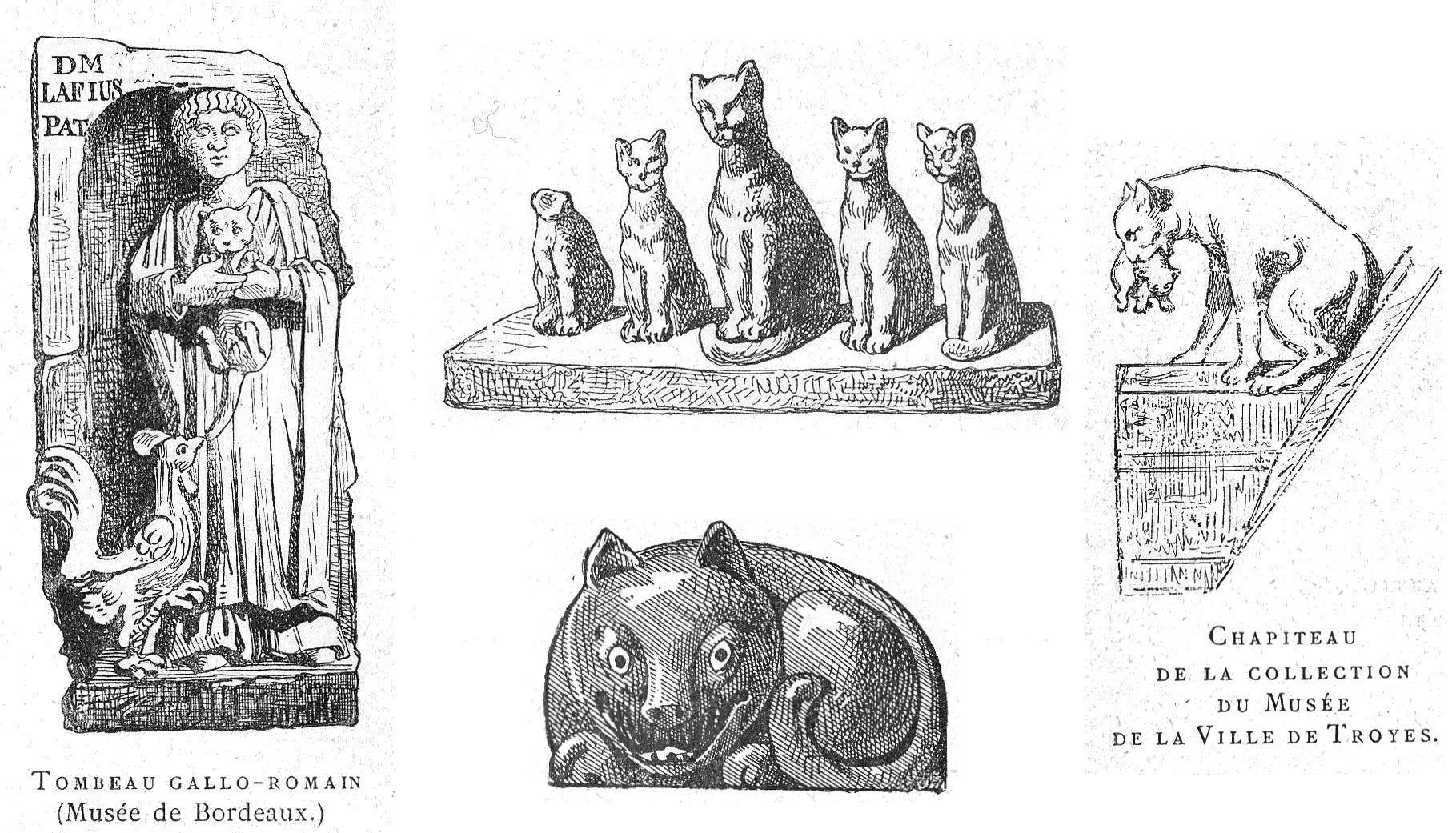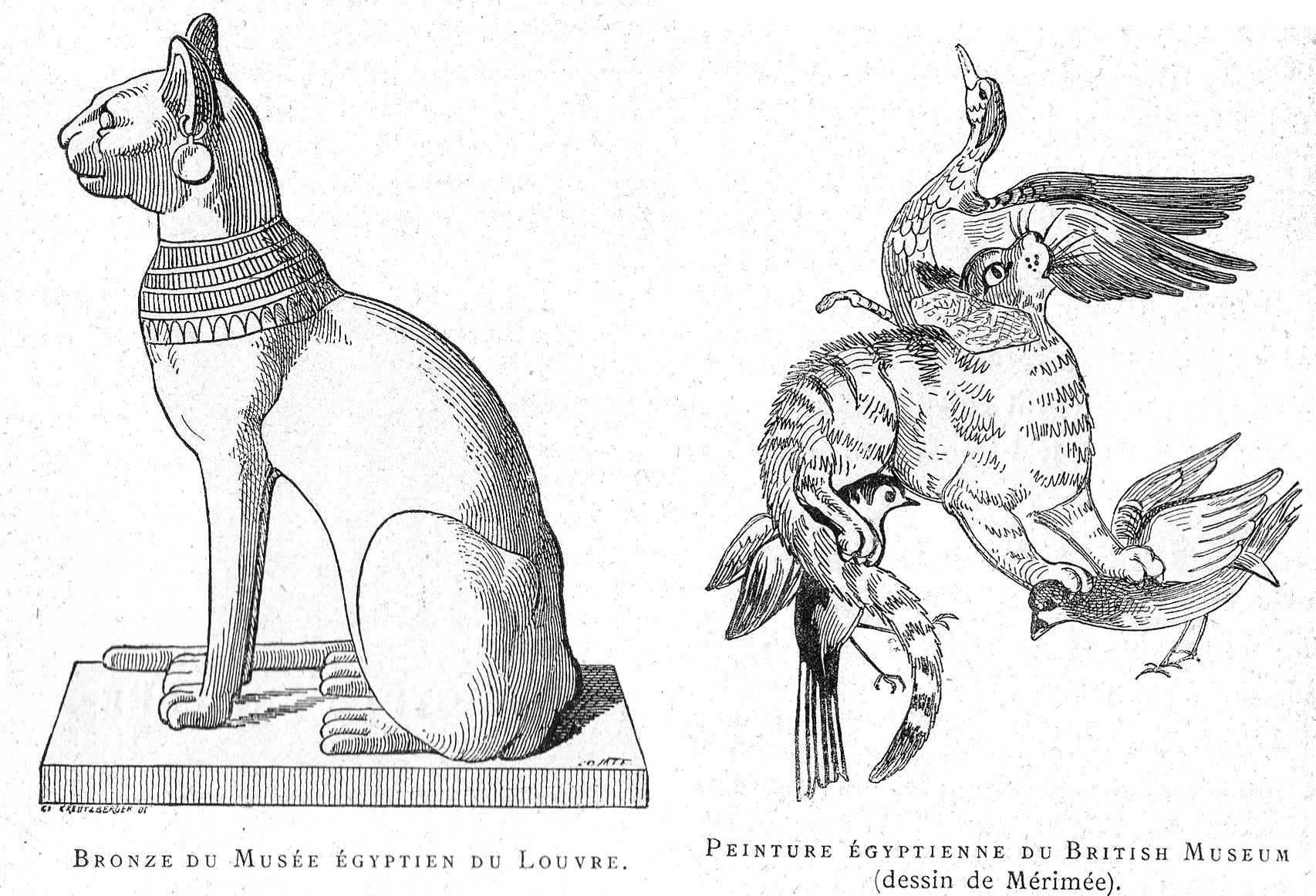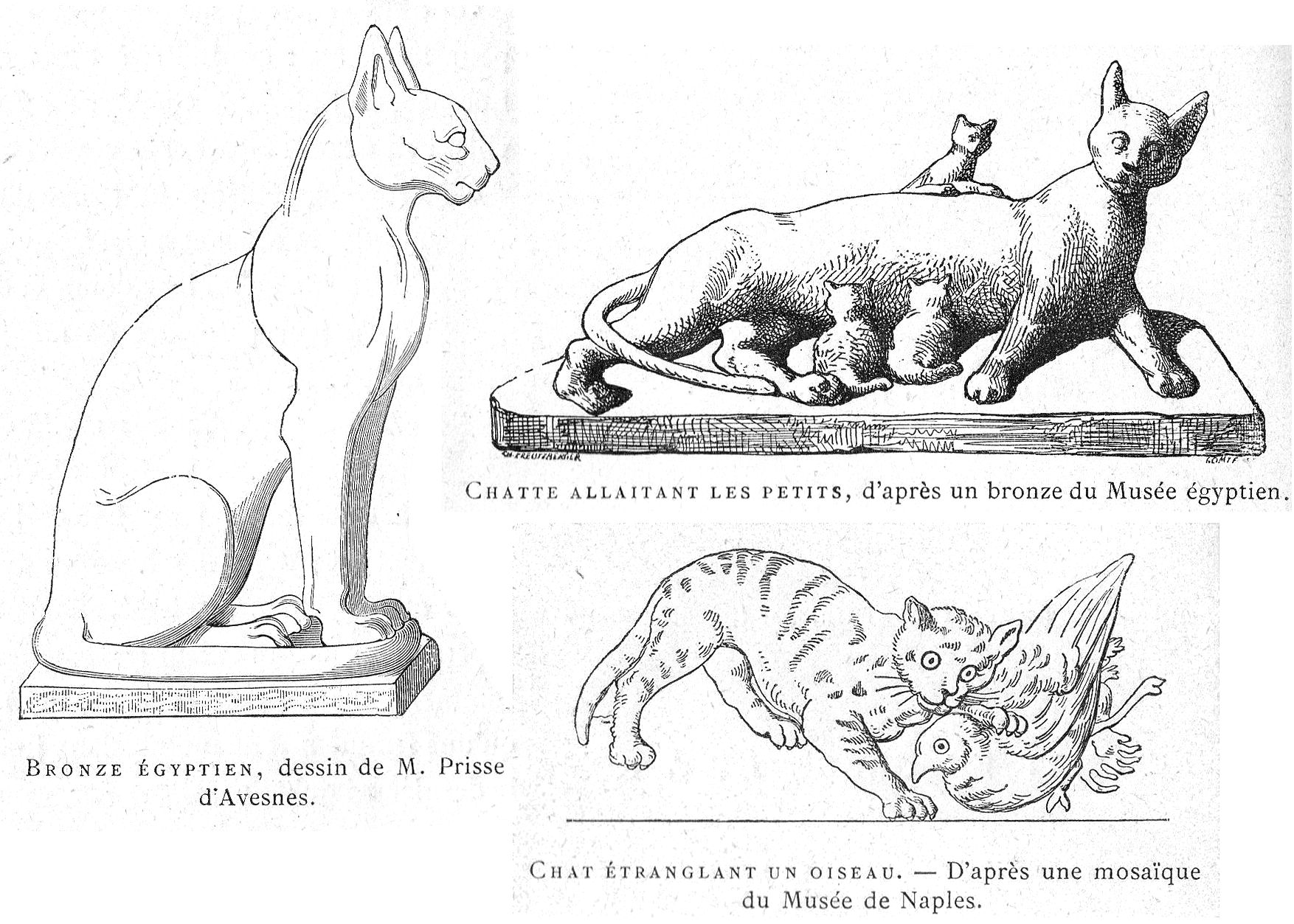
CATS IN CLASSICAL GREEK, ROME AND EGYPT
Naukratis (from the ancient Greek for "Naval Command") was a city and trading-post in ancient Egypt, located on the western-most branch of the Nile river, south-east of the more famous city of Alexandria. It was the first permanent Greek settlement in Egypt. The closest modern city is Damanhour. Naukratis was a cultural crossroads and a variety of sculptures have been found there. I am interested in those relating to cats. The cat sculptures are from the early Ptolemaic period (a dynasty of Greek rulers) and range in size from small to life-sized, carved in a range of styles and different materials.
Cats so rarely appeared in Greek and Roman sculpture, pottery, wall paintings or mosaics that many scholars believed cats were unknown in ancient Greece or Italy. Minoan art and Mycenaean bronzes borrowed contemporary New Kingdom Egyptian themes of cats hunting wildfowl, but the Greeks hardly represented cats at all, being unable to relate to Egyptian religion and rituals surrounding cats. Yet the Greeks depicted other domestic animals, furred prey and wildfowl in their art. The scarcity of cats in Greek and Roman art and literature is usually explained by the theory that the cat was a relative latecomer as a household pet in Greece, where weasels or snakes performed the role of rodent catcher. Domestic cats seem to have reached southern Italy and Cyrenaica from Egypt, before reaching most of the eastern Mediterranean. They reached the Greek mainland and islands relatively late, with representations of them becoming only slightly more common from the 4th century BC onwards, although they were still not popular household pets.
The earliest known Greek representation of a cat is an Archaic statue base in Athens, showing a naturalistic depiction of a dog and cat fight. The only figure of a cat on Classical Greek sculpture is on an Athenian funerary stele from Aegina c. 430 BC; it depicts a cat ready to pounce on a pet bird that is about to be put back into its cage by the owner. Cats are depicted on a few Attic red figure vessels but these could have been domestic cats, wild cats or small panthers. There are a few depictions of pet cats in art from Western Greek and Etruscan Italy from the 5th century BC onwards.
Domestic cats were even less common in Roman art. Mosaics of a cat hunting wildfowl found at Pompeii and near Rome represent the fashion for displaying Egyptian-themed art in early Imperial Roman Italy. The themes were copied from Egyptian art. Big cats were more common subjects in Greek and Roman sculpture as they represented ferocity and power. Some Gallo-Roman examples of cat sculpture were probably intended to represent big cats, rather than domestic cats. The Romans staged beast fights involving big cats, but an unskilled sculptor or artist might produce something that looks more like a domestic cat to modern eyes.

According to Paul Megnin (Our Friend the Cat, 1899), Champfleury, who had visited a large number of museums devoted to antiquity, said he had never seen a cat depicted on a vase, medal or in a fresco. Yet there are several representations of marble or bronze cats in the Vatican Museum. In the Medal Cabinet, there is an engraved carnelian depicting a scepter and an ear of corn separated by the inscription LVCCONIAE FELICVLAE. "The inscription upon the seal," writes M. Chabouillet, in his catalogue "gives us the names of its owner, a woman named Lucconia Felicula. Felicula signifies ‘Little Cat.’ The carving indicates a debased period in art."
Megnin also notes that a mosaic at the Museum of Naples - the art of mosaic dating from the reign of Sylla, about a year before the Christian era - represents a cat crunching a bird; and Millin, in his "Voyage to the South of France," says that he saw another mosaic at Orange - a cat attacking a mouse. These are the rare monuments in our museums dedicated to cats during the age of decadence. And as we advance through history representations of cats become more frequent. Thus at the Bordeaux Museum, in the Antiquities Room, there is a tomb dating back to the Gallo-Roman period. It represents a young girl holding a cat in her arms and with a cockerel at her feet. Just as children were buried with their toys at that time, they were also depicted with their pets.
Cats regularly featured in Egyptian art from the New Kingdom onwards. The Egyptians believed them to have protective powers and considered them sacred. They did not single out cats in this respect as their pantheon was full of animal-headed gods which presided over various aspects of human life. There was a growth of animal cults during the Late Period and Ptolemaic Period. Mummified cats, many bred to be sacrificed, mummified and sold as votive offerings, were dedicated to the goddess Bastet, a deity particularly revered in Lower Egypt. Bastet was later incorporated into the cult of Isis, and the sacred cat was also associated with the cult of Horus. This cult flourished under Ptolemy I and the image of the sacred cat spread with it.
Cats in Egyptian art were mainly in the form of limestone sculptures, stone and faience amulets, bronzes and carved wood. They also appear in paintings. The most common representation was the seated cat with its tail alongside it, which had a long tradition in Egypt. There were also Egyptian figurines depicting the goddess Bastet, in cat-headed humanoid form, sometimes accompanied with her children depicted as kittens. In Ptolemaic and Roman Egypt, terracotta cat figurines were produced in considerable numbers and a variety of poses.

Another motif was the life-sized marble cat-and-bird groups, such as those found at Naukratis. These were originally painted: blue birds and yellow cats. The types of marble and the workmanship indicated Greek workmanship c. 330–200 BC. Some of these are definitely domestic cats, but others are more leonine in form, perhaps due to the sculptor being more familiar with big cats. The birds were likely symbolic, blue being a symbolic colour, rather than a hunting depiction. The Limestone cats found at Naukratis were very varied and mostly carved without birds. They ranged in size from smaller than life to life-size and were depicted in a variety of poses – seated in the Egyptian style, reclining on their bellies or sides, prowling, etc - and in both Greek and Egyptian sculptural styles. Some were domestic cats, but others were more like poorly-proportioned lions although the sculptor probably intended them to be cats.
Cat sculptures were also found at the city of Alexandria where there was a Bubasteion (temple of Bastet). These included limestone figures of cats resting on their paws (“couchant”) holding a bird in the mouth, and a limestone figure of a female cat reclining on her side and suckling three kittens. Terracotta cats were also found there and were dated to 330–200 BC. Most of the limestone and terracotta cats from Alexandria depicted couchant cats, while the cats from Naukratis depicted moving, standing or seated cats.

The carved cats seem to be votive offerings dedicated within a Bubasteion at Naukratis in the period c. 325–227 BC. Those from Alexandria were c. 330–200 BC. This was a period when the cult of Bastet/Boubastis was peaking, the Ptolemaic rulers having subverted it into a queens-become-goddesses cult, and the Greek elite being keen to demonstrate their loyalty through votive offerings.
Whenever a large group of people, with their own religion, settle in a new land it is common for them to impose their religion on the inhabitants. The Greeks and Romans tended to assimilate native deities into their own pantheon (just as Christians assimilated pre-Christian festivals into their calendar). The Greeks associated the moon goddess aspect of Bastet/Boubastis with the moon goddess aspect of their goddess Artemis. Although the Greek-style cat sculptures may have been a new representation of Artemis, the Greek inhabitants of Naukratis and Alexandria were probably giving offerings to express their loyalty to the Ptolemaic Dynasty, rather than to Artemis/ Boubastis. The Romans independently adopted the Boubastis cults, associating Bastet with Diana (who was already associated with Artemis) and with cult centres in Rome and Pompeii. There was no direct connection between Diana cult centres and early Ptolemaic Bubasteions.
Berenike II re-founded the Bubasteion in Alexandria c. 244–221 BC. This coincided with her husband, Ptolemy III, moving Bubasteia (festival of the Bastet) to coincide with the Greek festival of Euergesia (philanthropy) which the Ptolemaic dynasty had brought with them. The Boubastis cults of Alexandria and (possibly) Naukratis became associated with the Ptolemaic queens. The votive cats represented the Greek elite’s support for cults and sanctuaries sponsored by and for deified Ptolemaic queens.
The cat votive sculptures were not typical of Greek or Egyptian religious or artistic styles. They were specifically early Ptolemaic expression of the Bastet cult that coincided with the dynastic propaganda (or religious assimilation) of deifying Ptolemaic queens and associating them with the goddess Isis who was associated with Bastet at that time. The cults of these deified queens persisted until the end of the Ptolemaic period, although they were already in decline during the 2nd and 1st centuries BC.
The few names found on the votive cat sculptures were Greek in origin. Greek worshippers were dedicating sculptures of a male or female cat catching a bird carved in a Greek style, sometimes with Greek inscriptions. Because these sculptures were so different in subject, style and material from the long-established Egyptian seated female cat, it seems that the sculptors and dedicants had diverged from the traditional Bastet cult of Egypt. They now used cat symbology for a queen-worship cult with a different audience (elite echelons of the Greeks who had settled in Naukratis and Alexandria and intermarried with Egyptians). The only inscription, sadly defaced, by a commoner was on an Egyptian-style seated cat found at the Naukratis Bubasteion, perhaps offered by someone who adhered to the traditional cults of Bastet rather than the subverted Ptolemaic queen-worship version.
You are visitor number